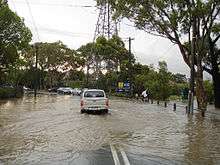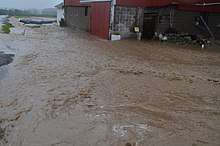Flash flood
.jpg)

A flash flood is a rapid flooding of geomorphic low-lying areas: washes, rivers, dry lakes and basins. It may be caused by heavy rain associated with a severe thunderstorm, hurricane, tropical storm, or meltwater from ice or snow flowing over ice sheets or snowfields. Flash floods may occur after the collapse of a natural ice or debris dam, or a human structure such as a man-made dam, as occurred before the Johnstown Flood of 1889. Flash floods are distinguished from regular floods by having a timescale of less than six hours.[1] The water that is temporarily available is often used by plants with rapid germination and short growth cycles and by specially adapted animal life.
Causes
Flash floods can occur under several types of conditions. Flash flooding occurs when it rains rapidly on saturated soil or dry soil that has poor absorption ability. The runoff collects in gullies and streams and, as they join to form larger volumes, often forms a fast flowing front of water and debris.
Flash floods most often occur in normally dry areas that have recently received precipitation, but they may be seen anywhere downstream from the source of the precipitation, even many miles from the source. In areas on or near volcanoes, flash floods have also occurred after eruptions, when glaciers have been melted by the intense heat. Flash floods are known to occur in the highest mountain ranges of the United States and are also common in the arid plains of the Southwestern United States. Flash flooding can also be caused by extensive rainfall released by hurricanes and other tropical storms, as well as the sudden thawing effect of ice dams.[2][3] Human activities can also cause flash floods to occur. When dams fail, a large quantity of water can be released and destroy everything in its path.[3]
Hazards

The United States National Weather Service gives the advice "Turn Around, Don't Drown" for flash floods; that is, it recommends that people get out of the area of a flash flood, rather than trying to cross it. Many people tend to underestimate the dangers of flash floods. What makes flash floods most dangerous is their sudden nature and fast-moving water. A vehicle provides little to no protection against being swept away; it may make people overconfident and less likely to avoid the flash flood. More than half of the fatalities attributed to flash floods are people swept away in vehicles when trying to cross flooded intersections.[4] As little as 2 feet (0.61 m) of water is enough to carry away most SUV-sized vehicles.[5] The U.S. National Weather Service reported in 2005 that, using a national 30-year average, more people die yearly in floods, 127 on average, than by lightning (73), tornadoes (65), or hurricanes (16).[6]
In deserts, flash floods can be particularly deadly for several reasons. First, storms in arid regions are infrequent, but they can deliver an enormous amount of water in a very short time. Second, these rains often fall on poorly absorbent and often clay-like soil, which greatly increases the amount of runoff that rivers and other water channels have to handle. These regions tend not to have the infrastructure that wetter regions have to divert water from structures and roads, such as storm drains, culverts, and retention basins, either because of sparse population or poverty, or because residents believe the risk of flash floods is not high enough to justify the expense. In fact, in some areas, desert roads frequently cross dry river and creek beds without bridges. From the driver's perspective, there may be clear weather, when a river unexpectedly forms ahead of or around the vehicle in a matter of seconds.[7] Finally, the lack of regular rain to clear water channels may cause flash floods in deserts to be headed by large amounts of debris, such as rocks, branches, and logs.
Deep slot canyons can be especially dangerous to hikers as they may be flooded by a storm that occurs on a mesa miles away. The flood sweeps through the canyon; the canyon makes it difficult to climb up and out of the way to avoid the flood.
Significant examples
- 1889: Johnstown Flood, Pennsylvania, U.S.: more than 2,200 people dead
- 1903: Heppner Flood of 1903; Oregon, United States: 247 dead, 25% of the city
- 1938: Los Angeles Flood of 1938, California, U.S.: 115 dead
- 1938: Kopuawhara flash flood of 1938, Mahia Peninsula, New Zealand: 21 dead
- 1952: Lynmouth disaster, England: 34 dead
- 1963: Petra Flash Flood, Jordan: 23 dead
- 1963: Vajont dam disaster, Italy: 1910 dead
- 1967: Flash flood in Lisbon, Portugal: 464 dead
- 1969: Nelson County, Virginia, US: 123 dead
- 1971: Kuala Lumpur floods, Malaysia: 32 dead
- 1972: The Black Hills flood, South Dakota, U.S.: 238 dead
- 1976: The Big Thompson River flood, Colorado, U.S.: 143 dead
- 1997: Antelope Canyon, a popular tourist attraction north of Page, Arizona:11 dead
- 2003: Bukit Lawang in Indonesia 239 people (5 of them were tourists) were killed
- 2006: Jember Regency in Indonesia 59 people dead
- 2007: Sudan floods, 64 dead.
- 2009: September 26 in Metro Manila primarily Marikina city, Taguig City, and Pasig City; and many municipalities of the provinces of Rizal, Bulacan and Laguna leaving more than 100 dead and thousands homeless. It also submerged several municipalities under feet of deep water for several weeks.
- 2009: October 1, Giampilieri, Messina, 37 dead. See also 2009 Messina floods and mudslides.
- 2010: Madeira archipelago, 42 dead
- 2011: Lockyer Valley, Queensland, Australia. 21 dead, mainly in the town of Grantham.
- 2011: Philippines, Cagayan de Oro and Iligan City, 17 December 2011. At least 1200 dead
- 2012: May 5, Nearly three weeks of damming left 72 dead in the Seti Gorge in Upper Seti Basin. Rock and avalanche fall from the western part of Annapurna IV mountain in Pokhara, Nepal.[8]
- 2012: Krasnodarskiy Kray, Russia. 172 dead following a flash flood that struck at 2 A.M. local time on 7 July. Main cities that were hit are Krymsk and Gelendzhik.[9][10]
- 2013: Uttarakhand, Uttarakhand, India: 822 dead
- 2013: November 17–19, Northeast Sardinia: 18 dead, 3000 homeless. See also 2013 Sardinia floods
- 2013: Port Louis, Mauritius: 11 dead
- 2013: Argentina floods: 99+ dead
- 2013: Kedarnath, Uttarakhand, India: approximately 5000 dead[11]
- 2014: Srinagar, Jammu & Kashmir, India: approximately 300 dead.[12]
- 2015: May 25, Central Texas floods: 25+ dead
- 2016: June 25, West Virginia floods: 24+ dead
- 2016: August 13, South Louisiana floods: 13 dead. [13]
- 2016: September 20, Garut Regency in Indonesia floods: 33 dead
- 2017: November 15, West Attiki, Greece floods: 23 dead
- 2018: April 26, Tzafit Canyon, Israel flood: 10 dead [14]
- 2018: August 20, Raganello Canyon, Italy flood: 10 dead [15]
- 2018: September 12, parts of Spain, Italy, France flood: 15 dead [16]
See also
References
- ↑ "Flash Flooding Definition". National Weather Service. Retrieved August 31, 2017.
- ↑ WeatherEye (2007). "Flash Flood!". Sinclair Acquisition IV, Inc. Archived from the original on 2009-02-27. Retrieved 2009-09-09.
- 1 2 National Weather Service Forecast Office Morristown, Tennessee (2006-03-07). "Definitions of flood and flash flood". National Weather Service Southern Region Headquarters. Retrieved 2009-09-09.
- ↑ "Watches, Warnings & Advisories—Flash Flood Warning". National Weather Service. Archived from the original on 2008-01-11. Retrieved 2007-06-25.
- ↑ "A Preparedness Guide to flash floods #1 weather-related killer in the United States". U.S. Department of Commerce, National Oceanic and Atmospheric Administration National Weather Service, Federal Emergency Management Agency, American Red Cross. July 1992. Retrieved 2007-06-25.
- ↑ "Turn Around Don't Drown". Retrieved 2007-06-25.
- ↑ McGuire, Thomas (2004). "Weather Hazards and the Changing Atmosphere" (PDF). Earth Science: The Physical Setting. Amsco School Pubns Inc. p. 571. ISBN 0-87720-196-X. Archived from the original (PDF) on 2008-06-25. Retrieved 2008-07-17.
- ↑ "Making Sense of Nepal's Seti River Disaster". earthobservatory.nasa.gov. 24 January 2014.
- ↑ "At least 105 dead as torrential rains inundate southern Russia". Los Angeles Times. 2012-07-07. Retrieved 2012-07-07.
- ↑ Kuzmin, Andrey (2012-07-08). "Russia's Putin demands answers after floods leave 150 dead". msnbc.com. Reuters. Retrieved 2012-07-08.
- ↑ "Uttarakhand: More than 5000 dead; 2000 still stranded". Business Standard. 2013-06-28. Retrieved 2013-06-28.
- ↑ Jane, Sophie (2014-09-07). "Hundreds killed by landslides and flash floods triggered by heavy monsoon rains in Kashmir". Dailymail.co.uk. Retrieved 2014-12-04.
- ↑ report, Advocate staff. "What caused the historic August 2016 flood, and what are the odds it could happen again?". The Advocate. Retrieved 2018-01-27.
- ↑ "9 YOUTH DEAD IN SOUTHERN ISRAEL FLASH FLOODS". Retrieved 2018-04-26.
- ↑ ecodellojonio.it (ed.). "Tragedia raganello: allerta gialla ignorata, tragedia evitabile" (in Italian). Retrieved 2018-08-21.
- ↑ bbc.com (ed.). "Search for missing after 15 killed in Europe floods". Retrieved 2018-10-12.
Further reading
- Schmittner, Karl-Erich; Pierre Giresse (August 1996). "Modelling and application of the geomorphic and environmental controls on flash flood flow". Geomorphology. 16 (4): 337–47. Bibcode:1996Geomo..16..337S. doi:10.1016/0169-555X(96)00002-5.
External links
| Wikimedia Commons has media related to Flash floods. |
| Wikivoyage has a travel guide for Flash floods. |
- Scottish Flash Flood on YouTube Public clip of the Fochabers flood in Moray September 9
- Decision tree to choose an uncertainty method for hydrological and hydraulic modelling, choosing an uncertainty analysis for flood modelling.
- Great footage of flash floods in the arid midwest heading down dry washes after heavy rain.
- Map of central Texas flash flood alley.
- Workshop Proceedings Flash Flood Management
- Workshop Proceedings Flash Flood Forecasting
- Hydrologic Research Center